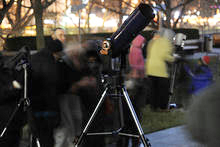Special Event: Winter Solstice Telescope Party
 When: Thu., Dec. 19, 2013 at 6:30 pm
When: Thu., Dec. 19, 2013 at 6:30 pmWhere: American Museum of Natural History
Central Park West at 79th Street
212-769-5100 Price: $15; $13.50 seniors and students; $12 members
Buy tickets/get more info now
See other events in these categories:
Join the museum’s Hayden astronomers and members of the Amateur Astronomers Association for winter solstice, the longest night of the year and “the best night to observe,” according to Christina Pease, the museum’s astrophysics educator and high school program manager who will be presenting at the telescope party about why we have seasons and what it means for winter solstice.
“The main thing that will be out is Orion and all his friends around him,” Pease says. “We’ll teach people how we can use Orion to spot others. If you’re able to find Orion, Jupiter will be northeast of Orion [at this time of year].”
Winter constellations include Gemini, Auriga, Canis Major while star clusters like Pleiades are also viewable in the winter night sky.
During the first part of the evening, astronomers will provide details on how to observe the night sky and provide a “sneak preview” of how things will appear in the real night sky from inside Hayden’s world-famous Space Theater, using its state-of-the-art Zeiss IX planetarium projector.
Then, weather permitting, the group, including members of the Amateur Astronomers, will head outside to the Ross Terrace to observe celestial objects.
“Astronomy is one of the oldest sciences. It dictates when farmers should plant, when to harvest. The sky has served as a marker in traditions, time, seasons, celebrations,” Pease says. “Through the ages and still today people look up and marvel and wonder about what lies beyond.”
Buy tickets/get more info now
 Discover More
Discover More